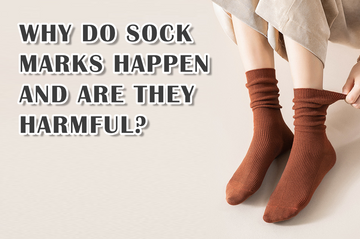Why Do Sock Marks Happen and Are They Harmful?
Sock marks, the indentations left on your skin after wearing socks, are a common occurrence for many people. These marks are usually harmless but can occasionally indicate underlying issues. Understanding why sock marks happen and when to take them seriously is essential for your health and comfort.
Why Do Sock Marks Happen?
Sock marks typically result from the combination of pressure and compression caused by socks. Here’s a breakdown of the common reasons:
1. Elastic Bands
Most socks have elastic bands designed to keep them in place. The tightness of the elastic applies pressure to your skin, leaving temporary indentations.
- Thicker Socks: Socks made with heavy or tightly woven materials, like thermal or compression socks, can create more pronounced marks.
- Extended Wear: Wearing socks for long periods amplifies the likelihood of visible marks.
2. Fluid Retention (Edema)
Fluid retention in the lower legs or feet can make sock marks more noticeable. This may occur due to:
- Prolonged Standing or Sitting: Staying in one position for long stretches can cause fluid to pool in your legs.
- Heat and Humidity: Warmer weather can lead to mild swelling in your feet.
- Pregnancy: Hormonal changes often cause fluid buildup, making sock marks more prominent.
3. Poor Circulation
Sock marks can also be linked to circulation issues. If blood flow is restricted, the tissue in your legs and feet may swell slightly, causing the socks to leave deeper marks.
- Tight Socks: Ill-fitting socks with excessive compression may reduce blood flow.
- Medical Conditions: Conditions like venous insufficiency or lymphedema can cause swelling and enhance the visibility of sock marks.
4. Skin Sensitivity
Individuals with sensitive or dry skin may experience more pronounced marks, as their skin is more prone to indentation from pressure.
Are Sock Marks Harmful?
In most cases, sock marks are not harmful and are simply a cosmetic or temporary issue. However, persistent or painful sock marks could signal a potential health concern. Here’s how to distinguish between harmless marks and those that might require attention:
When Sock Marks Are Harmless
- They disappear within a few minutes to an hour after removing your socks.
- There’s no pain, swelling, or discoloration in the affected area.
- They occur after wearing tight or elasticated socks for long periods.
When to Be Concerned
- Persistent Swelling: If sock marks are accompanied by swelling that doesn’t subside, it could indicate conditions like lymphedema or deep vein thrombosis (DVT).
- Skin Discoloration: If the area around the sock marks turns red, purple, or blue, it might suggest circulation problems.
- Pain or Tingling: These symptoms could point to nerve compression or poor blood flow.
- Frequent or Severe Marks: Repeated, deep marks might be a sign that your socks are too tight or that you have underlying fluid retention issues.
How to Prevent Sock Marks
If sock marks bother you or you experience them frequently, here are some steps to prevent them:
1. Choose the Right Socks
- Opt for socks made with breathable and stretchable fabrics, like bamboo. The GENTLEAGU bamboo socks are a great choice for comfort and light compression.
- Avoid overly tight socks or those with thick elastic bands.
2. Elevate Your Legs
Elevating your legs for 15-20 minutes daily can improve circulation and reduce fluid retention.
3. Stay Hydrated
Proper hydration helps prevent fluid buildup in your lower extremities, reducing the chance of noticeable sock marks.
4. Maintain an Active Lifestyle
Incorporate regular movement into your day to promote healthy blood flow and prevent swelling.
5. Monitor Medical Conditions
If you have a condition like diabetes, venous insufficiency, or lymphedema, follow your doctor’s advice to manage symptoms and reduce swelling.
Conclusion
Sock marks are usually harmless, resulting from the pressure of elastic bands or minor swelling in the feet. However, they can sometimes indicate underlying health issues such as circulation problems or fluid retention. If you experience persistent or painful marks, it’s worth consulting a healthcare professional. To prevent sock marks and stay comfortable, invest in high-quality, well-fitted socks like bamboo socks from Bulk Sockery, which are designed to be gentle on your skin while providing exceptional comfort.
